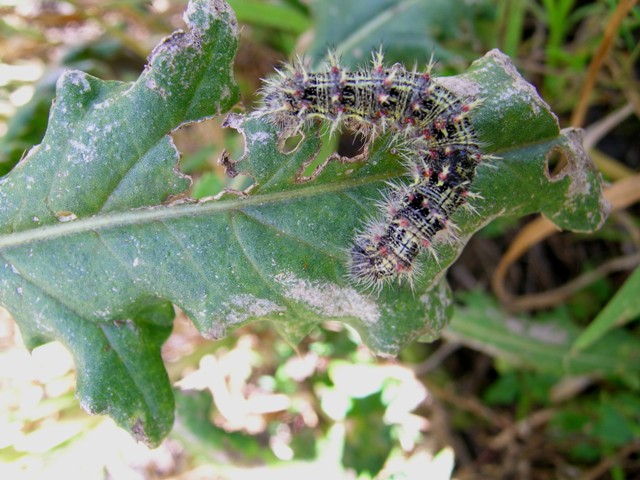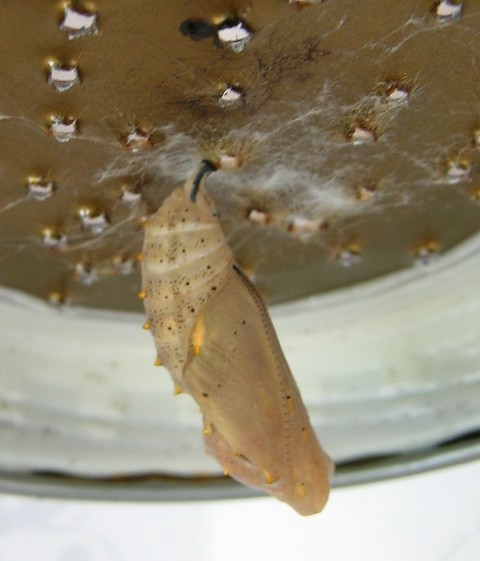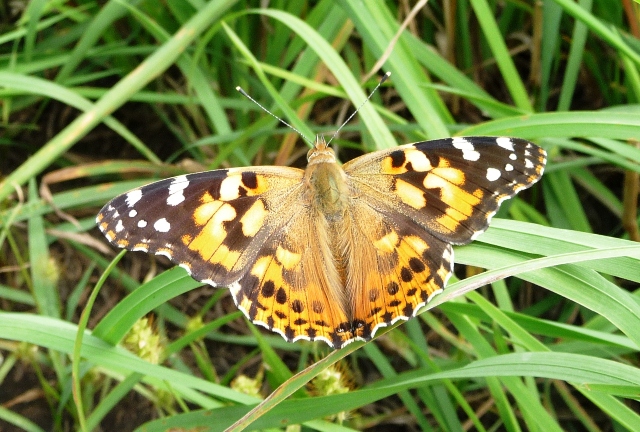Manitoba Insect & Disease Update
Issue 8: July 12, 2017
Summary
Insects:
Thistle caterpillar and their webbing continue to be quite noticeable in some soybean fields.
Aphids are at high levels in some cereal fields in the Central region.
Soybean aphid has been found in some fields in the Central region, but currently just at low levels.
Pathogens: Additional reports of stripe rust across Manitoba, with high severity showing up in fields/plots that did not receive a fungicide application. If the crop is past the flowering stage, a fungicide application is likely not warranted.
Stripe Rust
There have been continued reports of stripe rust in wheat crops across the province. In the MCVET trials (which do not receive a fungicide application), symptoms are severe with pustules even forming on the glumes and awns. If stripe rust has recently shown up in your crop it is important to assess the staging before considering a fungicide application. Research indicates that high severity of rust (or any leaf disease) on the flag leaf after the flowering stage is less likely to have an impact on yield. The table below illustrates the severity of leaf rust on the flag leaf and the predicted yield loss based on the stage of the crop.
Growth Stage |
Severity of Leaf Rust on Flag Leaf (%) | ||||
10 |
25 |
40 |
65 |
100 | |
Flowering |
10% yield loss |
15% yield loss |
20% yield loss |
30% yield loss |
35% yield loss |
Milk |
2% yield loss |
5% yield loss |
8% yield loss |
14% yield loss |
20% yield loss |
Soft Dough |
1% yield loss |
3% yield loss |
4% yield loss |
7% yield loss |
10% yield loss |
Hard Dough |
1% yield loss |
1% yield loss |
1% yield loss |
3% yield loss |
5% yield loss |
Thistle Caterpillar
Thistle caterpillar continues to be quite visible in many soybean and sunflower fields.
In the Carman area we are starting to see the caterpillars turn to pupae. Once they do their crop feeding stage (larvae) is done. The adult stage is a butterfly known as painted lady butterfly.


Fig . 1 Larva of thistle caterpillar Fig. 2. Pupa of thistle caterpillar

Fig. 3. Painted lady butterfly (adult of thistle caterpillar)
Thistle caterpillar larvae get to about 3 cm (1.25 inches) long. So once most are about an inch long they will be turning to pupae soon.
Thistle caterpillar is highly visible on plants, this being enhanced by the webbing they make and the frass that gets trapped in the webbing. So fields with even moderate levels can look quite bad. Do not confuse the webbing they make as being a cocoon. The pupal stage of this insect is shown in figure 2.
There are no insecticides registered in Canada for thistle caterpillars.
A Manitoba Agriculture factsheet with more information on thistle caterpillar is available at: http://www.gov.mb.ca/agriculture/crops/insects/thistle-caterpillar.html
Aphid Update
Some low levels of soybean aphid have been found on soybeans in the Central region of Manitoba.
Aphids are also present in cereal crops. Populations in cereals may be higher near field margins, particularly near shelterbelts, so assess for aphids well into the centre of the field. The economic threshold for aphids on cereals is an average of 12 to 15 aphids per stem prior to the soft dough stage. Rain and wind may decrease populations of aphids on cereal crops.
Natural predators (such as lady beetles, hover fly larvae and lacewings) and parasites can often keep populations of aphids under control. So look for these when out scouting as well.
Cereal Aphid Manager App: Research is currently underway to develop methods of incorporating natural enemies into management decisions for aphids in cereals. This will be done through an app (called cereal aphid manager) where both aphid and natural enemies levels are entered. An android version of the app is currently being field tested, with an iphone version coming soon. If anyone has an android device and is interested in being involved in the field testing, please contact John Gavloski (see contact information below).
Insect Monitoring Programs
Bertha Armyworm: Cumulative counts from traps for bertha armyworm are currently still all in the low risk range (less than 300). Highest counts so far are:
Table 1. Highest cumulative trap counts for bertha armyworm adults over the trapping period June 4 to July 11, 2017.
| Location | Region | Count |
|---|---|---|
| Napinka | Southwest | 258 |
| Tilston | Southwest | 232 |
| Benito | Northwest | 225 |
| Glenboro | Central | 222 |
| Benito | Northwest | 207 |
| Durban | Northwest | 181 |
A more detailed update of bertha armyworm counts in Manitoba is available on the Manitoba Agriculture website at: http://www.gov.mb.ca/agriculture/crops/insects/bertha-armyworm-forecast.html
----------------------------------------------------------------------------------------------------------------------
Compiled by:
John Gavloski, Entomologist Holly Derksen, Field Crop Pathologist
Manitoba Agriculture Manitoba Agriculture
Phone: (204) 750-0594 Phone: (204) 750-4248
To report observations on insects or plant pathogens that may be of interest or importance to farmers and agronomists in Manitoba, please send messages to the above contacts.
To be placed on an E-mail list so you will be notified immediately when new Manitoba Insect and Disease Updates are posted, please contact John Gavloski at the address or numbers listed above.

